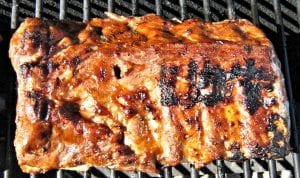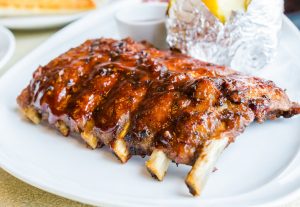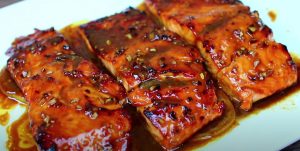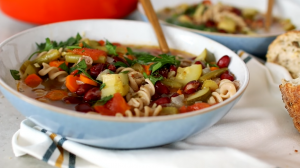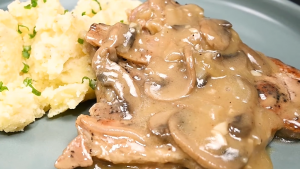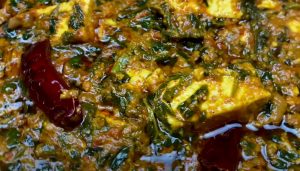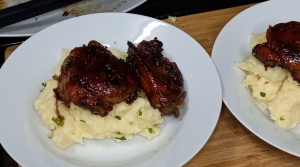Delight in the rich, savory flavors of Korean cuisine with these mouthwatering braised baby back ribs. The fusion of soy sauce, rice wine, and aromatic spices creates a tender, flavorful dish that will leave your taste buds craving more. Perfect for gatherings or a special dinner at home, these ribs are sure to impress.

Photos of Korean-Style Braised (Slow Cooker) Baby Back Ribs Recipe
Some ingredients like rice wine and light soy sauce might not be common in every kitchen. These can be found in the international aisle of most supermarkets or at an Asian grocery store. Fresh ginger root and jalapeno pepper can usually be found in the produce section.
Ingredients for Korean-Style Braised Baby Back Ribs
Baby back pork ribs: Tender and flavorful, these are the star of the dish.
Salt: Enhances the natural flavors of the ribs.
Canola oil: Used for browning the ribs.
Soy sauce: Adds a deep umami flavor.
Light soy sauce: Provides a milder, slightly sweeter soy flavor.
Rice wine: Adds a mild sweetness and depth to the sauce.
Onion: Adds sweetness and complexity to the sauce.
Orange juice: Adds a hint of citrusy sweetness.
Garlic: Adds a robust, aromatic flavor.
Fresh ginger root: Adds a warm, spicy undertone.
Jalapeno pepper: Adds a subtle heat to the dish.
Scallions: Used for garnish, adding a fresh, mild onion flavor.
One reader, Arly Stine says:





These Korean-style braised baby back ribs are incredible! The meat is tender and falls off the bone, and the flavors are perfectly balanced with a hint of spice. The broiler finish adds a delightful char. Highly recommend!
Techniques Required for Korean-Style Braised Baby Back Ribs
How to wash ribs: Rinse the ribs under cold running water to remove any bone fragments or impurities. Pat them dry with paper towels. How to brown ribs: Heat oil in a skillet over high heat. Add ribs and cook for 6 to 8 minutes, turning occasionally until browned on all sides. How to blend sauce: Place soy sauce, light soy sauce, rice wine, onion, orange juice, garlic, ginger, and jalapeno into a blender. Cover and blend until combined. How to use a slow cooker: Place browned ribs in a 3-quart slow cooker. Pour the blended sauce over the ribs. Cover and cook on high for 3 to 4 hours until the meat pulls away easily from the bone. How to broil ribs: Set oven rack about 6 inches from the heat source and preheat the oven's broiler. Place ribs on a baking sheet or roasting pan. Bake ribs under the preheated broiler for about 5 minutes until nicely charred but not burned. How to garnish with scallions: Thinly slice the scallions and sprinkle them over the charred ribs before serving.
How To Make Korean-Style Braised (Slow Cooker) Baby Back Ribs
Take 15 minutes to prep these delicious baby back ribs in a flavorful sauce and come back with a tender, slides-off-the-bone goodness perfect for dinner.
Serves:
Ingredients
- 2lbsbaby back pork ribs
- 1tspsalt,or to taste
- 1tbspcanola oil
- ½cupsoy sauce
- ½cuplight soy sauce
- ½cuprice wine
- ½onion,cut into quarters
- ¼cuporange juice
- 1headgarlic,chopped
- ¼cupfresh ginger root,minced
- 1jalapeno pepper,chopped
- 1bunchscallions,trimmed and chopped
Instructions
-
Wash ribs and pat dry. Salt ribs liberally.
-
Heat oil in a skillet over high heat. Add ribs. Cook for 6 to 8 minutes, turning occasionally until browned on all sides.
-
Place browned ribs in a 3-quart slow cooker.
-
Place soy sauce, light soy sauce, rice wine, onion, orange juice, garlic, ginger, and jalapeno into a blender. Cover and blend until combined.
-
Pour sauce over the ribs in the slow cooker. Cover and cook on High for 3 to 4 hours until the meat pulls away easily from the bone.
-
Set oven rack about 6 inches from the heat source and preheat the oven’s broiler. Place ribs on a baking sheet or roasting pan.
-
Bake ribs under the preheated broiler for about 5 minutes until nicely charred but not burned. Garnish with scallions.
Nutrition
- Calories: 659.72kcal
- Fat: 41.03g
- Saturated Fat: 13.45g
- Trans Fat: 0.33g
- Monounsaturated Fat: 17.84g
- Polyunsaturated Fat: 7.26g
- Carbohydrates: 15.38g
- Fiber: 1.99g
- Sugar: 3.28g
- Protein: 50.61g
- Cholesterol: 156.49mg
- Sodium: 3103.96mg
- Calcium: 141.49mg
- Potassium: 1033.81mg
- Iron: 3.38mg
- Vitamin A: 33.44µg
- Vitamin C: 22.57mg
Technique Tip for Perfecting Korean-Style Braised Baby Back Ribs
When browning the ribs in the skillet, make sure not to overcrowd the pan. Browning in batches if necessary ensures that each piece gets a proper sear, which enhances the flavor and texture of the ribs.
Time-Saving Tips for Making Braised Baby Back Ribs
Prepare ingredients in advance: Chop the onion, garlic, and ginger the night before to save time on the day of cooking.
Use pre-made sauce: Substitute the homemade sauce with a high-quality store-bought Korean BBQ sauce to cut down on preparation time.
Preheat the broiler: Preheat your oven's broiler while the ribs are finishing in the slow cooker to ensure a seamless transition.
Utilize a food processor: Use a food processor instead of a blender to quickly combine the soy sauce, rice wine, and other ingredients for the sauce.
Substitute Ingredients For Korean-Style Braised (Slow Cooker) Baby Back Ribs Recipe
baby back pork ribs - Substitute with beef short ribs: Beef short ribs provide a similar texture and can absorb the flavors well.
salt - Substitute with sea salt: Sea salt can provide a more nuanced flavor.
canola oil - Substitute with vegetable oil: Vegetable oil has a similar smoke point and neutral flavor.
soy sauce - Substitute with tamari: Tamari is a gluten-free alternative that offers a similar umami flavor.
light soy sauce - Substitute with low-sodium soy sauce: Low-sodium soy sauce can help control the saltiness of the dish.
rice wine - Substitute with dry sherry: Dry sherry provides a similar depth of flavor and acidity.
onion - Substitute with shallots: Shallots offer a milder and slightly sweeter flavor.
orange juice - Substitute with pineapple juice: Pineapple juice provides a similar sweetness and acidity.
garlic - Substitute with garlic powder: Garlic powder can be used in a pinch, though fresh garlic is preferred for its robust flavor.
fresh ginger root - Substitute with ground ginger: Ground ginger can be used, but it is more concentrated, so use less.
jalapeno pepper - Substitute with serrano pepper: Serrano peppers have a similar heat level and flavor profile.
scallions - Substitute with chives: Chives offer a similar mild onion flavor and can be used as a garnish.
Presentation Tips for Braised Baby Back Ribs
Serve smaller portion sizes: Cut the baby back pork ribs into individual ribs to create a more refined presentation. This allows each piece to be perfectly coated with the sauce and makes it easier for diners to enjoy.
Use decoration: Garnish the ribs with finely sliced scallions and a few thin slices of jalapeno pepper for a pop of color and a hint of heat. This adds visual appeal and enhances the overall flavor profile.
Plate with precision: Arrange the ribs in a neat, linear fashion on a pristine white plate. This creates a clean and sophisticated look, highlighting the beautifully charred exterior of the ribs.
Add a complementary side: Serve the ribs with a small portion of steamed jasmine rice or sticky rice molded into a neat shape using a ring mold. This not only adds texture but also helps balance the rich flavors of the dish.
Drizzle with sauce: Use a small spoon or squeeze bottle to drizzle a bit of the braising sauce over the ribs and around the plate. This adds a glossy finish and ensures that every bite is packed with flavor.
Incorporate fresh elements: Add a small salad of julienned carrots, cucumber, and radish dressed lightly with rice vinegar and sesame oil. This provides a refreshing contrast to the rich, savory ribs.
Highlight the aromatics: Place a few sprigs of fresh cilantro or microgreens on top of the ribs. This not only adds a burst of color but also enhances the aromatic experience of the dish.
Use a stylish serving vessel: Consider serving the ribs on a charcoal slate platter or a wooden board to give the dish a rustic yet elegant feel. This adds an extra layer of sophistication to the presentation.
Essential Tools for Making Korean-Style Braised Ribs
Skillet: Used to brown the ribs on all sides, ensuring a nice sear and caramelization.
Slow cooker: Cooks the ribs slowly and evenly, allowing the flavors to meld and the meat to become tender.
Blender: Blends the soy sauce, light soy sauce, rice wine, onion, orange juice, garlic, ginger, and jalapeno into a smooth sauce.
Baking sheet: Holds the ribs under the broiler to achieve a nicely charred finish.
Roasting pan: An alternative to the baking sheet for broiling the ribs.
Oven: Used to broil the ribs, giving them a final charred touch.
Tongs: Handy for turning the ribs in the skillet and transferring them to the slow cooker and baking sheet.
Knife: Essential for chopping the onion, garlic, ginger, and jalapeno before blending.
Cutting board: Provides a stable surface for chopping the ingredients.
Measuring cups: Used to measure out the soy sauce, light soy sauce, rice wine, and orange juice accurately.
Measuring spoons: Used to measure the salt and canola oil.
How To Store and Freeze Korean-Style Braised Baby Back Ribs
- Let the ribs cool completely before storing or freezing.
- To store in the refrigerator, place the cooled ribs in an airtight container or wrap them tightly with plastic wrap or aluminum foil. They will keep in the fridge for up to 4 days.
- For longer storage, freeze the ribs:
- Wrap the cooled ribs tightly in plastic wrap or aluminum foil, ensuring no air pockets remain.
- Place the wrapped ribs in a freezer-safe container or a resealable freezer bag, removing as much air as possible before sealing.
- Label the container or bag with the date and contents for easy reference.
- Frozen korean-style braised baby back ribs will maintain their best quality for up to 3 months.
- To reheat the ribs, thaw them overnight in the refrigerator if frozen.
- Preheat the oven to 350°F (175°C).
- Place the ribs in a baking dish and cover with foil to prevent them from drying out.
- Bake for 15-20 minutes, or until heated through.
- For extra caramelization, remove the foil during the last 5 minutes of reheating and brush the ribs with some reserved braising liquid or a mixture of soy sauce and honey.
How To Reheat Leftover Braised Baby Back Ribs
Preheat your oven to 350°F (175°C). Place the leftover ribs on a baking sheet lined with foil or parchment paper. Cover the ribs with another layer of foil to prevent them from drying out. Bake for 15-20 minutes, or until heated through. This method is ideal for reheating larger portions of ribs while maintaining their moisture and tenderness.
For a quicker option, use the microwave. Place the ribs on a microwave-safe plate and cover them with a damp paper towel. Microwave on high for 1-2 minutes, or until heated through. Be careful not to overheat, as this can cause the meat to become tough. This method is best for reheating small portions of ribs.
If you have a steamer basket, you can use it to reheat the ribs. Fill a pot with about an inch of water and bring it to a boil. Place the ribs in the steamer basket and set it over the boiling water. Cover the pot and steam the ribs for 5-7 minutes, or until heated through. This method helps to keep the ribs moist and tender.
For a crispy exterior, reheat the ribs on the grill. Preheat your grill to medium-high heat. Place the ribs on the grill and cook for 3-4 minutes on each side, or until heated through and slightly charred. Brush the ribs with some reserved braising sauce or barbecue sauce for added flavor.
If you have an air fryer, you can use it to reheat the ribs quickly and achieve a crispy exterior. Preheat the air fryer to 350°F (175°C). Place the ribs in the air fryer basket and cook for 3-5 minutes, or until heated through and crispy. This method is perfect for achieving a balance of tender meat and crispy edges.
Random Fact about Korean-Style Braised Baby Back Ribs
A unique aspect of this Korean-style braised baby back ribs recipe is the combination of soy sauce and orange juice, which creates a balance of savory and sweet flavors.
Is Making Korean-Style Braised Ribs at Home Economical?
This Korean-style braised baby back ribs recipe is moderately cost-effective. The primary expense is the baby back pork ribs, which can be around $12-$15 for 2 lbs. Additional ingredients like soy sauce, rice wine, onion, orange juice, garlic, ginger, and jalapeno are relatively inexpensive and often found in a well-stocked pantry. For a household of 4, the approximate cost is $20-$25. Overall Verdict: 7/10.
Are Korean-Style Braised Baby Back Ribs Healthy or Unhealthy?
The Korean-style braised baby back ribs recipe is a delicious and flavorful dish, but it may not be the healthiest option due to a few factors:
- The recipe uses a significant amount of soy sauce and light soy sauce, which are high in sodium. Excessive sodium intake can lead to high blood pressure and other health issues.
- The ribs themselves are high in fat, particularly saturated fat, which can contribute to heart disease and other health problems when consumed in excess.
- The recipe does not include a significant amount of vegetables, which are essential for a balanced and healthy diet.
To make this recipe healthier, consider the following suggestions:
- Reduce the amount of soy sauce and light soy sauce used in the recipe, or opt for low-sodium alternatives. You can also replace some of the soy sauce with other flavorful ingredients like rice vinegar or sesame oil.
- Trim excess fat from the ribs before cooking to reduce the overall fat content of the dish.
- Incorporate more vegetables into the recipe, such as sliced carrots, bell peppers, or bok choy. These can be added to the slow cooker along with the ribs to cook together and absorb the delicious flavors.
- Serve the ribs with a side of steamed or stir-fried vegetables to increase the nutritional value of the meal.
- Use lean cuts of pork, such as pork loin or tenderloin, instead of baby back ribs for a lower-fat alternative.
Editor's Thoughts on This Korean-Style Ribs Recipe
This recipe for Korean-style braised baby back ribs is a delightful fusion of flavors. The combination of soy sauces, rice wine, and orange juice creates a rich, savory, and slightly sweet marinade that deeply penetrates the meat. Browning the ribs before slow cooking adds a wonderful depth of flavor. Blending the aromatics ensures a smooth, cohesive sauce. The final broiling step adds a perfect char, enhancing the overall texture. Garnishing with scallions provides a fresh, vibrant finish. This dish is well-balanced and sure to impress.
Enhance Your Korean-Style Braised (Slow Cooker) Baby Back Ribs Recipe with These Unique Side Dishes:
Alternative Recipes Similar to Korean-Style Braised Ribs
Suggested Appetizers and Desserts to Serve with Braised Baby Back Ribs
Why trust this Korean-Style Braised (Slow Cooker) Baby Back Ribs Recipe:
This Korean-style braised baby back ribs recipe is a must-try for anyone seeking authentic flavors. The combination of soy sauce, rice wine, and orange juice creates a rich, savory sauce that perfectly complements the tender baby back pork ribs. The slow-cooking process ensures the meat is fall-off-the-bone tender, while a quick broil adds a delicious char. With fresh ingredients like ginger, garlic, and scallions, this dish promises a burst of flavor in every bite. Trust this recipe for a truly satisfying meal.
Was this page helpful?
Have your own special recipe to share? Submit Your Recipe Today!
